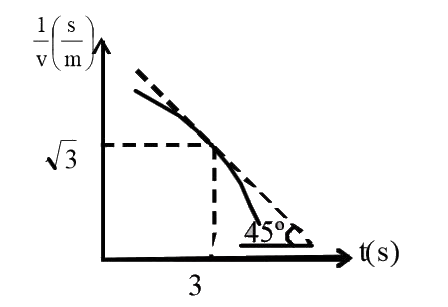In a circular motion of radius 3 cm the distance (s) travelled by a body along the circumference bears the relationship s=ct3 with time (t) where c= 0.1 m/s3 . What are the tangential and centripetal acceleration when its linear speed is 0.3 m/s?
0.2m/s2,3m/s2
2m/s2,0.6m/s2
0.6m/s2,3m/s2
2m/s2,4m/s2
The correct Answer is:C
s=ct3
∴v=dsdt=3ct2
anda=dVdt=6ct
when v=0.3m/s, then from (1)
0.3=0.1×t2 ∴t=1s
∴ The tangential accleration aT=6ct=6×0.1×1
=0.6m/s2
and C.P acceleration ,ac=v2r=0.3×0.30.03=3m/s2
Topper's Solved these Questions
- CIRCULAR MOTIONBOOK - MARVEL PUBLICATIONCHAPTER - CIRCULAR MOTIONEXERCISE - TEST YOUR GRASP-7
1 Video
- CIRCULAR MOTIONBOOK - MARVEL PUBLICATIONCHAPTER - CIRCULAR MOTIONEXERCISE - TEST YOUR GRASP-8
1 Video
- CIRCULAR MOTIONBOOK - MARVEL PUBLICATIONCHAPTER - CIRCULAR MOTIONEXERCISE - TEST YOUR GRASP-5
1 Video
- ATOMS, MOLECULES AND NUCLEI BOOK - MARVEL PUBLICATIONCHAPTER - ATOMS, MOLECULES AND NUCLEI EXERCISE - TEST YOUR GRASP
30 Videos
- COMMUNICATION SYSTEMS BOOK - MARVEL PUBLICATIONCHAPTER - COMMUNICATION SYSTEMS EXERCISE - TEST YOUR GRASP -20
10 Videos
Similar Questions
The equation of distance travelled by a body s with time t is given as S=A(t+B)+Ct2. The dimension of B is given by
View SolutionThe distance of a particle moving on a circle of radius 12 m measured from a fixed point on the circle and measured along the circle is given by s=2t3 (in meters). The ratio of its tangential to centripetal acceleration at t = 2s is
View Solution
Knowledge Check
If the distance s travelled by a body in time t is given by s=at+bt2 then the acceleration equals
A2at3+2bB2st2C2b−2at3Dst2The relationship between the displacement travelled by a body and the time t is described by the equation s=A+Bt+Ct2+Dt3. Where C=0.14m/s2 and D=0.01m/s3. In what time after motion begins will the acceleration of the body be equal to 1m/s2?
A10 secB50/3secC12 secD18 secIf the distance s travelled by a particle in time t is s=asint+bcos2t, then the acceleration at t=0 is
AaB−aC4bD−4b
The diagram shows variation of 1v with respect to time (where v is in m/s).

What is the instantaneous acceleration of body at t=3 sec. (inms2).
View SolutionAn electron moves along a circular path of radius 10 cm. If the centripetal acceleration is 4×1011m/s2 , then its linear speed is
View SolutionIf the distance 's' metres travelled by a particle in t seconds is given by s=t3−3t2, then the acceleration is zero (in m/s) is
View SolutionThe distance s (in cm) travelled by a particle in t seconds is given by, s=t3+2t2+t. The speed of the particle after 1s will be :
View SolutionThe distance s (in cm) travelled by a particle in t seconds is given by, s=t3+2t2+t. The speed of the particle after 1s will be :
View Solution